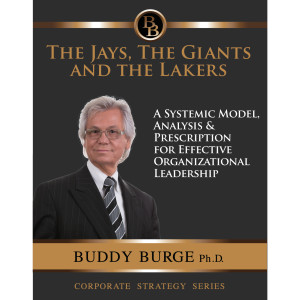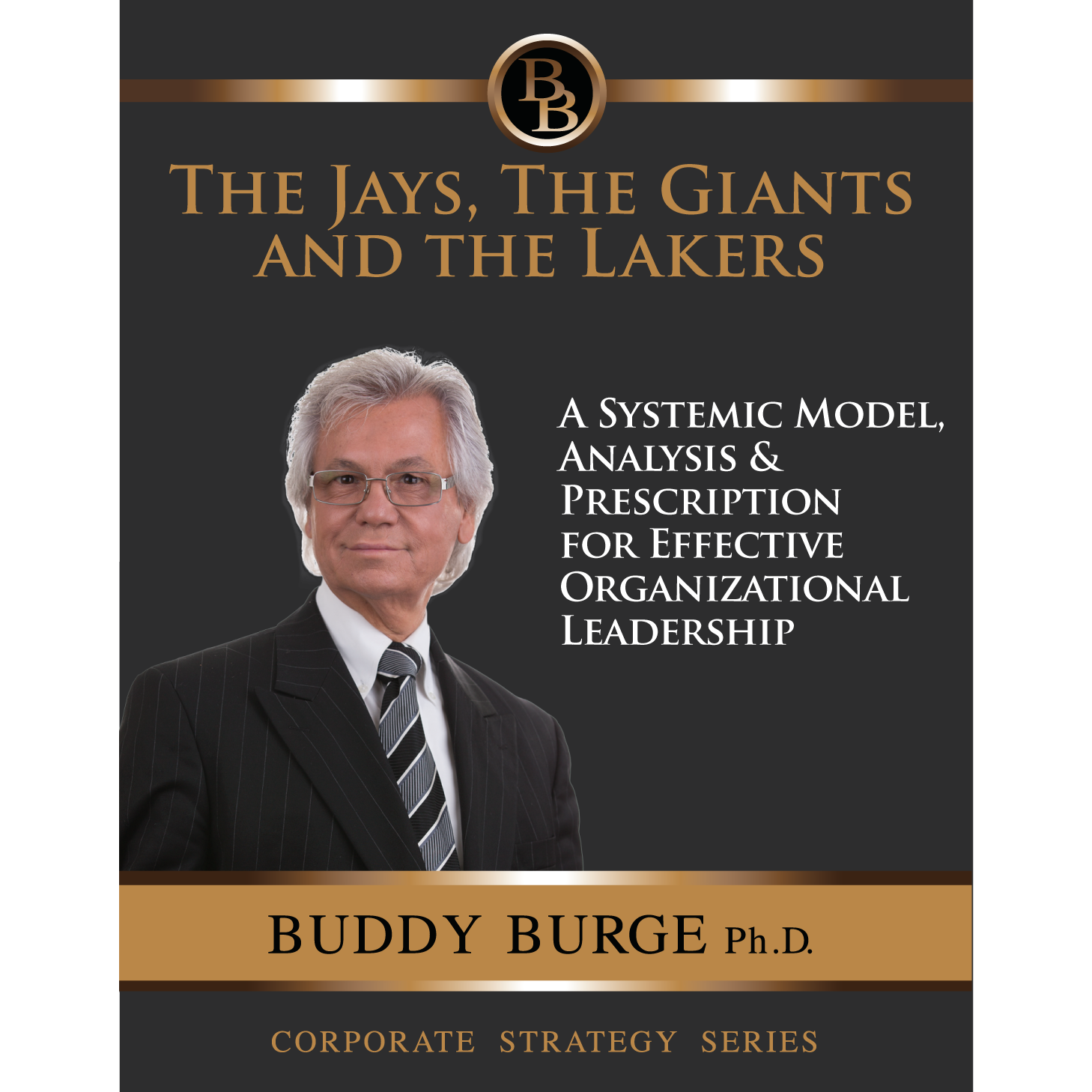The following excerpt is taken from “The Jays, the Giants and the Lakers”
The Three Sports Model for Organizational Structure and Employee Behavior
An Organizational Systems Analogy for the Twenty First Century: Premise
The Most powerful Determinant, What makes People do What They do, in your Company is Your Organizational System
Organizational structure, systems and work interdependence (your business process) are the prime determining factors for high sales volume, customer loyalty, employee performance and productivity.
The role in the organizational system (and its’ attendant and requisite tasks) that people are called upon to play is the most powerful determinant to human behavior in any company.
![CropperCapture[479]](http://buddyburge.com/wp-content/uploads/2014/02/CropperCapture479-300x294.png)
In Other Words, Systems Tend to Cause their own Behavior
Why, because in any company, adjusting to the system (doing their job or assigned role) is how people survive!
Systems reward, measure, encourage and promote requisite behaviors.
When placed in the same system, people however different they may otherwise be, tend to act and function in a similar manner.
For example, the accountant and sales person’s conflict would be opposite if their roles were reversed.
For a more comprehensive discussion on what systems are and what they do, see Appendix A.
The Three Sports Model for Organizational Structure and Employee Behavior
In any/every company, three systemic factors/forces determine people’s interactional style and behaviors, that is to say the way they function, feel and relate to each other as they do.
Fortuitously, the three major team sports in North America, Baseball, Football and Basketball, which for our purposes is interchangeable with Hockey are a model (reflect, reveal and determine in concrete terms) for the three business systems consistently but unwittingly used by modern organizations to effectively run their operations.
Model: A Definition and a Caution
An elegant model is a useful simplification of reality.
It enables you to ignore a mass of irrelevant or less relevant details so you can focus on what is most important.
It also shows what to look for; helps identify meaningful patterns, and aids in interpreting what you see.
Einstein said that it is more important for a model be useful or helpful than to be right.
Why People do What They do in your Organization and What to do About It
Systems Tend to Cause their own Behaviour
The system is organizational design, in other words the way people are measured and rewarded to meet your company’s goals, your organization uses is the most powerful determinant for people’s interactional style and behaviour.
Companies consistently but unwittingly use three systems to effectively run their operations.
Most companies have a primary or dominant organizational system/game, Football, Basketball or Baseball.
Given the task at hand, however, companies, leaders, groups and employees will sometimes find themselves playing a secondary and/or even a tertiary game.
.![CropperCapture[62]](http://buddyburge.com/wp-content/uploads/2014/02/CropperCapture62.png)
The Three Sports Organizational Model
Every company is a lot like a Baseball, Football or Basketball team or a combination thereof.
1. Baseball:
If it is like a Baseball team, then the players are using their own initiative, pretty much independently of each other and the manager.
Baseball is a highly individualistic sport that calls for only occasional or situational teamwork.
It consists primarily of independent production: to discover, sell, invent, create or design something.
Examples:
Sales, researchers, teachers, or consultants (Proctor and Gamble: A.G. Lafley).
2. Football:
If it is like a Football team, then the structure encourages the manager to call the shots for everyone else.
It demands systematic teamwork.
Effective performance depends on top-down orchestration of a complicated but predictable set of sequential activities.
The system rewards comprehensive planning, coordination and execution.
Examples:
Ford factory, I. B. M., McDonald’s.
3. Basketball
If the organization resembles a Basketball team, then the players win by how they share the ball and coordinate themselves as a group (cooperate), with the manager (the coach) acting as a catalyst.
Basketball requires spontaneous teamwork.
The speed of the game precludes the kind of top-down direction characteristic of Football.
Instead, coordination in Basketball is through mutual adjustment by the players to each other.
Roles are cross-functional, reciprocal, interdependent &integrated across departments, markets, products, technologies, & other dimensions.
Examples:
Senior management team.
Are We Playing The Right Game, in the Right Way?
Characteristics for the Three Organizational Sports Model
![CropperCapture[575]](http://buddyburge.com/wp-content/uploads/2014/04/CropperCapture575.png)
The Three Sport Organizational Model: An Overview
![CropperCapture[577]](http://buddyburge.com/wp-content/uploads/2014/04/CropperCapture577.png)
The Problem: The Systemic Reason That People Find Themselves In Conflict!
People and organizations get into difficulties when, for example:
1. One person is expecting everyone will be working independently as on a Baseball team (sales),
2. While the others are expecting everyone to function interdependently like members of a Basketball team (operations or finance),
3. Or the leader is expecting everyone to comply with his vision, strategy and system like a good Football team (manufacturing).
What Makes People Do What They Do?
In every organization there are three strategic settings or systems which promote, reward, measure very real social interactions:
1. Football, the organization, requires compliance or you will be sanitized.
2. Basketball, the team, requires cooperation or you will be ostracized.
3. Baseball requires initiative (competition amongst its members) or you will be pulverized.
Said Succinctly, Leaders Need and Want Three Things From People.
1. Leaders (of Football type situations) want and need people’s “compliance for” the organization.
2. Leaders (of Basketball type situations) want and need people’s “cooperation with” the team.
3. Leaders (of Baseball type situations) want and need people’s “competition against” other individuals.
Key Team/Organizational Question:
The first question we ask is not “what is the best way to run this organization or build our build a great team” but firstly, “what game are we playing right now” because each game is governed by very different principles.
When you are stuck or you need to get better, the two crucial “Systemic/Macro” questions to ask which provide a detached, depersonalized, objective viewpoint for team conflict are:
Given the Task at Hand:
1. Are We Playing the Right Game?
2. Are We Playing the Right Game, in the Right Way?
Whenever, as a leader, you are confronted with a “people issue”, ask these two questions immediately.
I think you will be pleasantly surprised as to how much they help create (systemic) clarity for everybody concerned.
In part two, we will discuss the practical applications and implications the three system sports analogy and how an executives can use this paradigm to be a more complete and powerful leader.
For more on this topic, we recommend the following | |
 | The Jays, the Giants and the LakersA Systemic Model, Analysis, and Prescription Click Here For Video and Full Description If you found this article useful |


![CropperCapture[65]](http://buddyburge.com/wp-content/uploads/2014/02/CropperCapture651.png)
![CropperCapture[64]](http://buddyburge.com/wp-content/uploads/2014/02/CropperCapture64.png)
![CropperCapture[63]](http://buddyburge.com/wp-content/uploads/2014/02/CropperCapture63.png)
![CropperCapture[65]](http://buddyburge.com/wp-content/uploads/2014/02/CropperCapture65.png)
![CropperCapture[487]](http://buddyburge.com/wp-content/uploads/2014/02/CropperCapture487-298x300.png)
![CropperCapture[488]](http://buddyburge.com/wp-content/uploads/2014/02/CropperCapture488.png)
